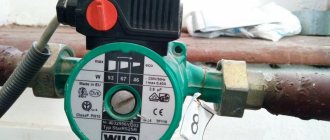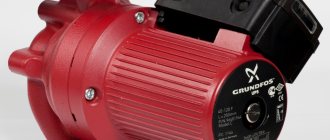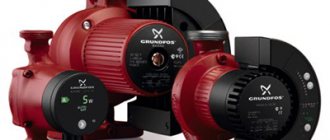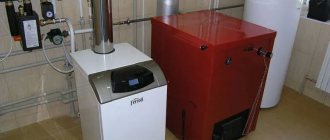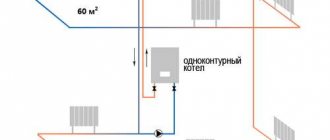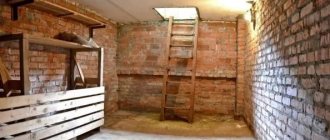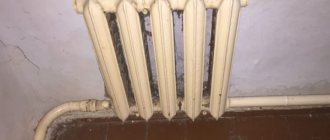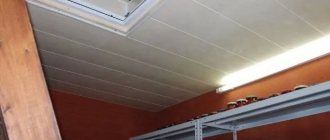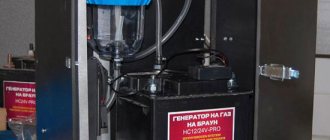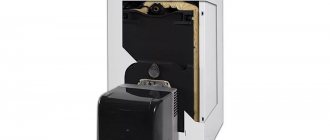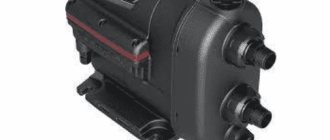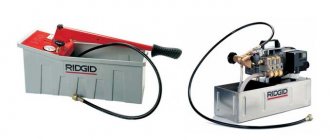The key element of the heating system is the circulation pump. With the help of this equipment, heat is evenly distributed throughout the room. Depending on the quality of the device, the water pressure and the efficiency of its heating will change.
Not all users know how to choose these devices correctly and what technical characteristics to pay attention to. At the moment, there are many manufacturers of this type of equipment. WILO circulation pumps for heating systems are in great demand among consumers.
Heating circulation pump Wilo
The company has existed for a century and a half . During this time, its name has become a symbol of quality and reliability. Since 2008, the name Wilo SE has been approved.
If you need to complete a heating system, then a Wilo pump will be the best choice.
Specifications
- productivity 2.2-6 cubic meters per hour ;
- power depends on the given frequency and is in the range of 39–176 W ;
- rotation speed 0.1-4.8 thousand rpm. ;
- pumps cold water with temperatures below zero ( down to -10°C );
- pumps hot water up to 110°C ;
- weight - 2-8 kg.
Installing a pump will extend the service life of the heating boiler and will save fuel or electricity.
Important! A circulation pump is a means of increasing the pressure in the system pipeline, regardless of the configuration. Even a simple low-power unit can increase heating efficiency.
Benefits of Wilo products
The device is designed for comfortable use:
- reliability, simple design, compactness;
- cataphoresis coating protects against rust;
- made from quality materials;
- manual pumping speed adjustment;
- the motor does not respond to blocking currents and does not need a relay;
- dry running protection;
- tolerates hot environments up to 40°C , installed in boiler rooms;
- Self-installation is possible .
Judging by the reviews of product users, there are no shortcomings.
Wilo pumps are suitable for customers with any income level. The cost of a simple device starts from 2500-3000 rubles , powerful models for multi-storey buildings can be purchased for 150-230 thousand rubles.
Components of the device
The circulation pump consists of several elements:
- frame;
- working chamber;
- engine;
- rotor;
- impeller;
- automation.
Wilo engines are available in a wide range for any system configuration. There are products with powerful motors that create excellent pressure.
Electrical repair
The electrical part of the pump includes the following components:
- inductor;
- starting capacitor;
- connecting wires;
- control terminal.
If the stator winding breaks down, the pump becomes unrepairable; all other components can be repaired or replaced. To analyze the condition of electrical parts, you will need an ohmmeter.
Photo of the circulation pump Wilo MTSL 15/5 HE – 2.
Main symptoms of malfunction
If the boiler display shows an error code corresponding to a water circulation problem, and it is not reset, the problem may be hidden in the electronic part of the device.
Circulation pump with cover removed.
To identify the problem you must:
- Turn off the heating mode in the boiler, and after stopping all components, turn off the power (soft stop).
- Open the front panel of the case.
- If the pump is covered with a large layer of dust, clean its surface.
- Using the information in the diagram, remove the control terminals and remove the terminal with the capacitor.
- Visually examine the condition of the pump contacts and terminals; they should be free of oxides, burnouts and mechanical damage.
- Using a tester in diode testing mode, determine the integrity of the connecting wires that go from the control board to the pump.
- Use an ohmmeter to determine the resistance of the inductors. On a working device, the instrument readings on the contacts will correspond to the following values:
- No. 1, 4 – 150 – 160 Ohm;
- No. 1, 6 – 290 – 300 Ohm;
- No. 2, 3 - 0 (contacts connected together);
- No. 3, 5 – 220 -230 Ohm;
- No. 4, 6 – 150 – 160 Ohm.
- The device will be considered faulty if the ohmmeter reading on any of the above pair of marks is 1 (winding wire break) or 0 (short circuit, except for contacts 2,3).
- Check the condition of the starting capacitor. To do this, switch the tester regulator to the 20 microfarad capacity test mode. Connect the probes of the device to the terminals of the capacitor and determine its capacitance. It should match the nominal ± 10%. Loss of capacity leads to a decrease in pump performance; it will emit an uncharacteristic hum.
Electrical diagram of the pump Wilo MTSL 15/5 HE – 2.
Measuring the resistance of the circulation pump windings.
Types of pumping devices
There are two main types of circulation pumps for heating systems.
With dry rotor
Devices of this type are characterized by increased power.
The main parts of the pump do not come into contact with the pumped medium because they are located in a sealed chamber.
Photo 1. Circulation pump from the manufacturer Wilo with a dry rotor. There is a fan at the back to cool the parts of the device.
Such a device is capable of creating a pressure column of up to 15 meters , but a dry rotor means some problems:
- Regular maintenance is required;
- there is noise when the engine is running;
- running dry means periodic wear and tear, which will require action.
In the event of a breakdown, you will have to replace spare parts , which are made from expensive materials and have a significant cost.
With wet rotor
This variety is more unpretentious and does not require attention from the owner.
Maintenance-free as the device does not need to be cleaned or lubricated. The role of a lubricant is performed by a coolant that comes into contact with moving parts of the equipment.
Due to this, the pump does not make noise, does not wear out and consumes little energy.
Photo 2. Circulation pump from the manufacturer Wilo with a wet rotor. It is less demanding than the dry type of device.
Harness
There are two types of heating systems: forced and natural circulation. Systems with forced circulation cannot work without a pump; systems with natural circulation work, but in this mode they have less heat transfer. However, less heat is still much better than no heat at all, because in areas where power is often interrupted, the system is designed like a plumbing system (with natural circulation), so a pump is placed in it. This gives high heating efficiency and reliability. It is clear that the installation of the circulation pump in these systems is different.
All heating systems with heated floors are required - without a pump, the coolant will not pass through such large circuits
Forced circulation
Since a forced circulation heating system does not work without a pump, it is installed directly into the gap in the supply or return pipe (optional).
Most problems with the circulation pump arise due to the presence of mechanical impurities (sand, other abrasive particles) in the coolant. They are able to block the impeller and stop the engine. Therefore, it is necessary to install a sump filter in front of the unit.
Installing a circulation pump in a forced circulation system
It is also advisable to install ball valves on both sides. They will allow you to replace or repair the device without draining the coolant from the system. Close the taps and remove the unit. Only that part of the water that was directly in this part of the system is drained.
Natural circulation
The circulation pump piping in gravity systems has one significant difference - a bypass is required. This is a jumper that allows the system to operate when the pump is not running. A ball shut-off valve is installed on the bypass, which is closed as long as the pump is running. In this mode, the system operates as forced.
Installation diagram of a circulation pump in a natural circulation system
When the power or unit is turned off, the valve on the jumper opens, the valve leading to the pump closes, and the system operates as a gravity system.
Installation features
There is an important point, without which the installation of the circulation pump will require modifications: it is necessary to rotate the rotor so that it is directed horizontally. The second point is the direction of flow. There is an arrow on the housing indicating the direction in which the coolant should flow. So turn the unit so that the direction of movement of the coolant is “in the direction of the arrow”.
The pump itself can be installed both horizontally and vertically, just when choosing a model, make sure that it can operate in both positions. And one more thing: with a vertical arrangement, the power (pressure created) decreases by about 30%. This must be taken into account when choosing a model.
Selecting a Grundfos pump
Before purchasing a device, consumers primarily focus on cost. Wilo prices are justifiably considered low, however, other manufacturers also have inexpensive pumps.
For example, Grundfos. The cheapest model, which is comparable to Wilo prices, is Grundfos UPS 25-40 180 (costs about 5 thousand rubles ). The device creates a pressure column of up to 4 meters and pumps liquid at a speed of 3.5 cubic meters per hour . Acceptable temperature is from 2 to 120°C .
Grundfos UPS is the most popular line of models and has the following features:
- switching speeds;
- silent operation;
- wet rotor;
- Possibility of installation in heating and air conditioning systems.
Expensive options have the best technical characteristics. The model of this series 25-80 N 180 creates a pole up to 9 meters , while the price is 5 times higher .
Reference. The parameters of the device do not always determine the cost.
To make the right and economical choice, you should carefully study the specifications of each specific model.
If the pump is selected for domestic use, then more often this means a single-phase electrical network ( number 100 in the name ). If the network is three-phase, then the suitable device is marked with the number 200.
Design features are also significant. Some models have additional rotor protection (“anti-jamming”), which reduces the risk of failure.
Basic problems and methods for resolving them
In cases where vibration appears during operation of the device, extraneous noise occurs, or the pressure in the system changes, you should determine the cause and, if possible, troubleshoot the problem yourself.
When turned on, the pump hums, but the shaft does not rotate:
- The shaft jammed due to prolonged downtime. Remove the protective cap on the motor housing and rotate the shaft using a flat-head screwdriver;
- if foreign objects get in, disassemble the pump and clean the impeller, after which replacing the cleaning filter, which is installed in front of the device;
- problems with power supply (insufficient voltage in the network).
When turned on, the device does not work:
- there is no voltage in the network. Electrical wiring and protective automation are checked;
- The fuse has blown. Replaced with a new one.
Automatic shutdown of the device after a short period of operation:
accumulation of limescale in the stator cup. The glass and rotor of the electric motor are cleaned.
The pump makes a lot of noise when running:
- dry operation with air in the system. Release the air and make sure the pump shell is filled with liquid;
- cavitation. The pressure in the fluid supply line must be increased.
Excessive pump vibration:
critical condition of support bearings due to severe wear. The bearings should be replaced.
Reduced head and flow compared to manufacturer's specifications:
- power supply failure or phase change, which leads to a drop in power or reverse rotation of the impeller. Checking the phases (three-phase motors) and replacing the capacitor (for single-phase power supply);
- the pipeline has great resistance to fluid movement (hydraulic resistance). Clean (replace) the filters, check the shut-off valves, and increase the diameter of the pipes if necessary.
Automatic pump shutdown by external protection system:
malfunction of the electrical components of the device. Check connection terminals (oxidation, short circuit), capacitor (replacement), control unit.
Features of the models
The manufacturer Wilo has several popular models of circulation pumps.
Wilo-RS 25 6
Manufacturer's model, which creates a pressure column of 6 meters.
Advantages:
- wet rotor, speed adjustable;
- the motor does not respond to blocking currents, there is no need for a relay;
- coolant with a temperature in the range ( from -10°C to 110°C );
- a filter is installed in front of the cartridge, which increases the reliability of the pump;
- operates with full functionality at ambient temperatures up to 40°C ;
- simple installation;
- takes up little space (installation length - 180 mm ).
Wilo Star RS Series
A line of compact, reliable pumps for domestic use.
The letters in the name mean the characteristics of the product:
- RS - type, rotor, fittings;
- Then there are numbers indicating the connection diameter, pressure, and pipe diameter.
The pump is capable of providing constant pressure in the heating system, but it is important to choose the right option, taking into account the following factors:
- head column in meters;
- pump flow (the amount of water that it is capable of pumping per unit of time).
Photo 3. Wilo circulation pump model Star RS. The device is a wet rotor device.
These values are provided by the manufacturer , who tests the device under conditions as close as possible to real ones. The documentation for the pump contains graphs reflecting the pressure and flow capabilities of the pump.
Main characteristics:
- pressure column;
- power (depending on frequency);
- the pressure in the system reaches 10 bar .
Designed for pumping only clean water; glycol can be added in the ratio 1:1.
Peculiarities:
- The engine does not require additional devices , is resistant to blocking currents, and does not respond to voltage surges.
- The rotation speed is switched ; for this purpose, there is a toggle switch on the terminal box with markings of different sizes. This helps achieve the optimal temperature in the house and helps save energy.
- To remove air from the system, which leads to idle operation of the device, a special screw is used.
Using the frequency change function makes it possible to reduce power consumption by up to 50% . If the temperature drops, the frequency will have to be increased. If noise occurs when the frequency is too high, lowering the frequency will help reduce it.
These universal devices are used:
- for pumping cold and hot water;
- in cooling and air conditioning circuits;
- in homes and businesses.
Mechanical repair
All other parts that are not listed in the section: “Electrical repair” refer to mechanical components. If vibration or noise occurs in a running pump, to determine the source of its occurrence it is necessary:
- Stop the boiler smoothly.
- Remove the front panel of the housing and lower the control unit.
- Close the cold water, supply and return taps.
- Drain water from the boiler system through the drain valve.
- Unscrew the pump air vent lock to completely drain the water from the system. After all the fluid has been drained, tighten the lock until it stops.
- Remove the terminal with the starting capacitor.
- Unscrew the fastening screws and remove the motor-turbine unit.
- Inspect the bearings, impeller, and pump cavity for oxidation, contamination, foreign objects, and damage. If there is wear on the bearings or the motor shaft rotates with force, then they need to be replaced with others, for example, fluoroplastic ones. All dirt from the turbine, internal compartments of the housing, and sealing rubber should be removed.
- Place the repaired mechanism in place and secure it.
- Insert the terminal with the capacitor.
- Open the return, supply and cold water taps.
- Using the make-up tap, check the pump for leaks; if it does not leak, then add coolant to the system up to 1.2 bar.
- Start the pump in circulation mode and check its condition.
- If the results are positive, set the heating circuit temperature control knob to the required position.
The service life of the Wilo circulation pump and other boiler components can be extended if full maintenance is carried out before each heating season.
Possible causes and methods of eliminating coolant overheating in double-circuit, automatic and semi-automatic gas heating boilers are described.
The article describes five practical methods for eliminating icing on a coaxial air duct.
The principle of operation is considered, the main signs and causes of the malfunction are shown, methods for diagnosing and repairing the fan (smoke exhauster) of a gas boiler.
The main reasons for changes in pressure in a closed heating system are listed, and effective ways to stabilize the coolant pressure are given.
Let's look at what to do if a gas water heater with a semi-automatic ignition system does not light up, the principle of operation of the ignition system, the reasons.
Connecting the device
Heating efficiency and uniform distribution of heat throughout the rooms is ensured by a properly selected circulation pump . It is important to install it correctly; a lot also depends on this.
Self-installation does not require professional knowledge, but there are several important points.
Connection point
It can be installed on any section of the circuit, but professionals recommend choosing a return pipe.
Photo 4. Diagram of the heating system. The circulation pump is installed on the return circuit.
Installation in a heating system
The water is shut off, the pipes are cut according to the installation length of the product. Before installation, check in which position, horizontal or vertical, the pump should operate. The joints are then sealed and tightened. They think about connecting to the power grid in advance.
Filters
It is recommended to install additional coarse filters ; this will protect the device from accidental ingress of particles and significantly reduce the likelihood of failure.
Separate pocket
Sometimes, for ease of maintenance and repair of the pump, installation is carried out in a separate pocket . For this, an additional branch of half a meter in length is created. Valves are installed at the ends, which allow you to disconnect the device from the general circuit at the right time. In this case, there is no need to shut down the system - the valves are closed, the pump is removed from its place and sent for repair, and the structure continues to operate.
Photo 5. Special pocket for the circulation pump. There are valves at the edges of the structure.
A circulation pump is a device that provides a given speed of movement of the coolant (water or oil) through the pipeline of the heating system. Thanks to it, the water circulating through the pipes returns to the boiler faster, without having time to cool, which leads to a reduction in energy costs for reheating and gas savings, which can reach 20-30%.
This article presents circulation pumps for heating systems from the company Wilo (Italy). We will review the most popular equipment models, and also give recommendations for their installation and repair.
Briefly about the Vilo company
The WILO Group is the world's leading manufacturer of pumping equipment used in households, utilities and industry. The company was founded back in 1872, when its founder, Louis Uplander, began producing hardware.
WILO is currently a leader in digital innovation. The company compares favorably with its competitors with highly efficient and energy-saving solutions, which allows it to produce high-quality equipment according to German standards. Now the enterprises of this company are open all over the world, their number reaches 60.
The VILO RUS division, founded in 1997, operates on the domestic market. Now it includes 30 branches. In 2016, we opened our own service center, which specializes in repairing WILO equipment.
Peculiarities
Not all manufacturers can offer a good productive liquid transfer station. As a rare exception, we can name the German concern Wilo, whose pumps can be presented in various variations. All proposed models are distinguished by high-quality ergonomics and modern controls.
Wilo pumps can be used to provide hot water supply to any heating systems and various air conditioning systems; they are considered the most versatile type of equipment, which is intended for small areas of the residential sector, supplying multi-storey buildings and industrial applications.
Advantages of pumps from Wilo:
- versatility and wide scope of application;
- significant savings;
- compact dimensions of components;
- corrosion protection;
- reliability and durability of the device;
- overheat protection;
- reliable cleaning system;
- reasonable prices.
The technical characteristics of Wilo heating circulation devices include several parameters.
- Convenient control in the form of a mechanical or electronic switch. You can adjust the power and speed of the coolant.
- Models with electronic control have a built-in thermostat.
- The electric motor and rotor will be protected from electrical surges.
- Operating characteristics of the device: water column pressure from 1 to 7.5 m, heated area - from 100 to 2200 m2, throughput - from 1 to 12 m3 per hour. Operating temperature parameters from -10C to + 110C.
The manufacturer offers the consumer an assortment whose technical characteristics are almost identical, the main difference being only in the flange parameters.
Wilo Star Series
The Star-RS unit is a low-power device that is perfect for home use. The body is made of high-quality cast iron, the impeller is made of plastic, and the shaft is made of stainless steel. Used for pumping clean water that does not contain abrasive substances or various impurities.
The RS series includes 12 samples, which are named from 15-4 to 30-8. These circulating heating products have a capacity of 6,000 liters per hour at a normal pressure of 10 atmospheres.
- Star-RS 25/4 is a surface-type pump for clean water, capacity - 3 m3 per hour, water pressure - 4 m, power 68 W.
- The Wilo 25/6 pump is purchased for supplying water to small heating systems and closed systems.
They can be chosen for apartment buildings and private houses.
- The circulation device Wilo Star-RS 25/7 for heating systems is a three-speed equipment with a threaded connection type.
- Product Wilo Star RS 25/2 with threaded connection and wet rotor. Designed for installation in air conditioning, heating and cold water supply systems, as well as in industrial systems.
- Wilo Star series Z Nova is a device with a wet rotor and a synchronous electric motor, resistant to blocking currents, used in industry for equipment of various types of structures.
- Wilo-Star-RS 30/8 units are used to work in different temperature parameters: with ventilation units, with various radiators, underfloor heating systems. And they are also used in air conditioning systems.
- Star-RSD is a dual mechanism that increases operational reliability: when the first mechanism breaks down, the second one starts working automatically. With another option, the devices operate simultaneously, but water will be supplied through different lines: separately for heating and hot water.
You can choose one of two models: 30-4 and 30-6.
Wilo Stratos-Eco
This is the most advanced electronic version, which was released for the operation of boiler rooms with low power. The device regulator will control the operation of any heating system, which guarantees savings in resource use and its operation at the lowest temperatures. The Wilo product is presented in seven markings: from 25/1-8 to 65/1-2, which are equipped with a wet rotor and are suitable for hot water supply with a large volume of oxygen.
The Wilo Stratos-Zd has a pre-speed for continuous automatic day-night operation. Available in 2 types: 32/1-12 and 40/1-8.
Wilo Top and DHW
This series is used for heating systems of premises that have an area of more than 1,500 m2. Circulation devices of the Wilo Top brand have a water pressure of up to 10 m of water column with a working pressure of 10 bar. Among Wilo Top you can find flanged pumps.
- Top-Rl and Top-S are two-phase equipment that provides high-quality work in continuous mode. The pumps operate at temperatures from -20 to +130 C and can be used for a separate circuit in closed-type water supply and hot water supply systems.
- Top-S 40/10 – maintenance-free, has a threaded or flanged connection; If desired, you can select speed stages for precise power control.
- The Top-S 50/15 pump can be used for various water heating systems, air conditioning, refrigeration and industrial circulation systems.
- The Top-Z series unit is needed for pumping water for drinking. Silent operation is ensured by the wet rotor design. Full protection of such a motor is guaranteed by an electronic shutdown system.
Pumping equipment is placed even in the most unsuitable places.
Heating equipment Wilo
The company released these devices, which also work for domestic hot water supply, not so long ago. This equipment is adapted to water with a relative degree of hardness with a low content of magnesium and calcium. In models of this series, the impeller is made of stainless steel.
Latest Arrivals
E.syboxmini – the world's most compact electronic pressure booster system! Happy Independence Day Ukraine! EVOTRON circulation pumps with a “wet” rotor and frequency regulation The Vulver company at the Aqua-Therm Kiev 2015 exhibition GENIX - a new pressure station for collecting and automatically pumping fecal wastewater Submersible 4″ electric motor DAB Centrifugal pump DAB K-HA Greetings from Novy Rok! Help the guys who are defending our Motherland! Hydraulic accumulators GWS ATTENTION, FAKE! The season is in full swing! Autumn offer New series of DAB filters for forward filtration Vertical centrifugal pumps of the NKV 32, NKV 45 series Representatives of the Wulver company visited the 18th international exhibition on water treatment, water purification, recycling and waste disposal, IFAT 2014. Horizontal frequency-controlled pump KDNE MCE/P Horizon nal frequency-controlled pump KDNE MSE/S Cavitation is a risk factor Horizontal frequency-regulated pump KE Dab monoblock frequency-controlled pumps NKM-GE/NKP-GE MSE/S Centrifugal pumps with built-in pre-filter - EUROPRO EVOPLUS SAN - glandless circulation pump and electronic control for the hot water system ERHARD ROCO Premium - innovative butterfly valve EVOPLUS D - double glandless circulation pump with electronic control
DABDAB sewer pumpsAqua-Therm KievDomestic pumping stationsValve valves with a rubber wedgeSewer pumpsPumping stationCirculation pumps DABdomestic pumping stationwater supplychoice of a pumping stationchoice of a well pumpwhere to buy a water pumpdeep pumps for wellswhy do you need a check valvehow to choose a circulation pumpbuy a pump for a wellbuy dab pumpsbuy a check valvebuy a circus lation pumpDab pumppump for seweragepump for well buypumping station Dabpumping equipment DABpumping stations DABpumping stations for increasing pressuredab pumps Ukrainepumps for heating systemswaste water treatmentsubmersible pumps dabsubmersible pumps for wellssubmersible well pumpsselection of a pumping stationsale of pumping equipmentsale of pumping equipment dabsale of pumping equipment Ukraineself-priming pumps dabwell pumps dabpressure increasing stationspressure increasing installation for the homesewage pumpcentrifugal pumps DABcentrifugal pumps for wells
Device
The company produces pumps of two subtypes:
- with dry rotor;
- with a wet rotor.
Dry rotor pumps
This type of pump means that the rotor of the electric motor does not have contact with water. The connection of the motor itself with the working part is made using special sealing rings, which will not allow the liquid used to end up in the electric drive.
This unit consists of two parts: the 1st part is the electric motor itself, the 2nd part is a housing with two pipes - one discharge pipe, the other suction. In addition, it has an impeller that performs pumping.
This type of pump is used in systems with a fairly long length of pipelines and a large diameter. Most often they can be found in industrial and heating boiler houses.
Main indicators of the device:
- high level of efficiency - more than 80%;
- It is necessary to install filters to prevent foreign objects and particles from entering the product.
The room where this equipment will be installed must be free of dust, otherwise the O-rings will quickly become unusable. Replacing the rings will be quite difficult; only a specialist can do this. The connection type is usually flanged.
Wet rotor units
This product is often used for household needs. The design of such pumps will differ significantly from other models. The electric motor and impeller are located in the housing itself, which has both an inlet and an outlet. The coolant is transferred as if by the rotor itself, which is equipped with an impeller.
The bearings are cooled and lubricated by the pumped liquid itself. This product is used in heating systems with short lengths and small diameters of pipelines. They are connected with a threaded connection.
Key equipment indicators:
- almost silent operation;
- has the most compact design;
- if necessary, you can change the operating parameters, which will help seriously save on electricity consumption;
- long service life;
- requires almost no constant maintenance.
Models of units with a wet rotor for various heating systems are equipped with three-mode units for adjusting the speed of the impeller. These blocks are controlled manually. The temperature parameters in which such units can operate range from -20 to +130 degrees.
To correctly connect the selected pump, be sure to read the electrical connection diagram, and best of all, contact an experienced specialist.
Where to put
It is recommended to install the circulation pump after the boiler, before the first branch, but on the supply or return pipeline - it does not matter. Modern units are made from materials that can withstand temperatures up to 100-115°C. Few heating systems operate with warmer coolant, so considerations of a more "comfortable" temperature are not acceptable, but if you feel calmer, put it in the return line.
Can be installed in the return or straight pipe after/before the boiler before the first branch
There is no difference in plumbing - the boiler and the rest of the system do not matter whether there is a pump in the supply or return line. Correct installation in terms of piping and correct orientation of the rotor in space are important. Nothing else matters.
There is an important point at the installation site. If the heating system has two separate branches - on the right and left wings of the house or on the first and second floors - it makes sense to install them on each separate block, rather than a common one - immediately after the boiler. In addition, the same rule remains on these branches: immediately after the boiler, before the first branch of this heating circuit. This will allow you to set the required thermal conditions in each part of the house independently of the other, and also save on heating in two-story houses. Like? Due to the fact that the second floor is usually much warmer than the first and requires much less heat. If there are two pumps in the ascending branch, the coolant speed is set much lower, and this allows you to burn less fuel, without compromising living comfort.
Installation
The installation of a Wilo unit in a heating system must be carried out in full compliance with the existing operating instructions provided by the manufacturer. There are several important rules to follow during installation.
- Only vertical installation of units from this company is allowed. Horizontal placement of Wilo pumps into the system is strictly prohibited. The only exceptions will be those models that are specifically designed for horizontal connection. The installation position of a specific pump can be found in the detailed instructions.
- Connecting a heated floor system - the device is installed in a special unit. The correct placement of the Wilo heating product will be indicated by arrows located on the body of the unit itself and on the hydraulic wiring.
- Connection to a radiator-type heating system - installation is carried out in the heating return, directly in front of the boiler. In order to prevent a complete stop of coolant circulation, a bypass is also installed here.
The rules for installing Wilo devices allow you to select equipment for heating systems with both natural circulation and forced circulation.
- Installation and maintenance - the pump is mounted vertically in compliance with the direction of the coolant, which will be indicated by arrows on the body and assembly. Installation should only be performed by qualified technicians.
- Methods for installing the device will depend on the selected model; as a rule, they are described in some detail in the instructions. If connected correctly, the Wilo pump will not require any special maintenance.
- You need to place a coarse filter on the bypass frame immediately in front of the pump. Only an experienced specialist can take into account all the specifics of installing a Wilo heating pump, disassemble and reassemble it, and carry out repairs. Installation of the device is completed in just 2-3 hours.
If you also install a bypass, it will take 4-6 hours.
Connection steps:
- the pump is assembled, the connection location on the circuit is selected;
- the water is turned off, a connection to the heating system occurs;
- the device is mounted, the main thing is to install it in the correct position;
- connections are tightened and sealed;
- the product is connected to electricity;
- the liquid is supplied to the circuit and the device starts;
- tested in operating mode.
An extraneous hum when the device is operating will indicate a number of possible malfunctions. The air vent may become clogged, resulting in air not being removed from the system. Another common malfunction will be an incorrectly selected operating mode.
Reducing the speed of the device with your own hands usually leads to the disappearance of the hum. If this does not happen, the pump needs to be serviced.
How to recognize a fake
WILO is a popular equipment, so now you can often stumble upon a fake. If the product is original, it is covered by a warranty. A separate category is the Chinese WILO pumps, whose service life is only 2–3 years, while the original can last up to 15 years.
How to visually identify a fake:
- The original packaging has a cubic shape with high-quality glossy paint. Fakes are placed in a rectangular box.
- A sticker is attached to the original device; for fakes, the article number, serial number and other data are printed.
- The serial number is not stamped on the body of the counterfeit device.
- On the original the arrow showing the direction of water movement is large, on Chinese products it is small.
In addition to visual qualities, you should also pay attention to the internal design.
Differences:
- The rotor and stator are marked on their housings, indicating the serial number and date of manufacture.
- In original models, the upper part of the device is detached from the rotor, which makes the device repairable.
- Electronics must also be marked.
These are the key points by which you can distinguish the original from a Chinese fake.
Tips for use
We can offer several key recommendations that will ensure long-term operation of this type of equipment.
- You can leave the device in constant operation mode without fear.
- Experts advise sometimes turning on the equipment for 10-20 minutes after the heating season has ended.
- You can turn on the equipment only if the heating system is filled with media.
- Models that have a wet rotor in their structure use a coolant for lubrication. When turned on, if there is no lubricant, the bearings can burn out very quickly.
You can learn how to connect a circulation pump to a heating system from the following video.
What is important to know?
The connection diagram and methods of connecting a device such as a circulation pump to electricity can be of different designs. The choice of a specific option is determined by the characteristics of the heated object, as well as the location where the device is located. You can connect it in two ways:
- direct connection to 220 V power supply;
- connection to an uninterruptible power supply, which in turn is connected to a 220 V or 220/380 V network (in the case of a three-phase UPS).
By choosing the first method, the consumer risks being left without heating in the event of a prolonged power outage. This option can be considered justified only if there is a high degree of reliability of power supply, minimizing the likelihood of a long-term power outage, as well as if there is a backup source of electricity at the site. The second method is preferable, although it requires additional costs.
with terminal box types.
with terminal box types 5, 6, 7 (Fig. 4): The switching plug in the terminal box can be set to a maximum of two or three stages (depending on the terminal box type). Unscrew the fastening screws, remove the terminal box cover, remove the switching plug (Fig. 4, item 3) from the socket with the pump turned off and connect it in such a way that the marking of the plug points to the symbol of the desired speed level. The set speed stage can be recognized through the inspection window even when the terminal box cover is closed.
The pump must be taken out of service before carrying out maintenance and repair work, as well as before dismantling.
DANGEROUS! Life threat! When working with electrical devices, there is a danger to life due to electric shock.
• Work on the electrical components of the pump may only be carried out
only to a qualified electrician.
• When carrying out any maintenance work and
During repairs, the pump must be de-energized and protected from unauthorized activation.
CAREFULLY! Risk of burns! Depending on the operating state of the pump or installation (temperature of the pumped medium), the entire pump can become very hot. There is a risk of burns from contact with the pump. Allow the unit and pump to cool to room temperature.
9 Maintenance
Before starting maintenance, cleaning and repair work, familiarize yourself with the contents of the chapters “Decommissioning” and “Removing/installing the motor”. Follow the safety instructions in chapters 2.6, 7 and 8. After successful maintenance and repair work, install and/or connect the pump in accordance with chapter “Installation and electrical connection”. The installation is switched on in accordance with the “Commissioning” chapter.
